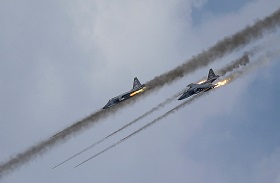Two days after Vladimir Putin’s speech at the UN General Assembly in New York Russia launched an anti-terrorist campaign in Syria. Nothing in the President’s speech indicated that Russia would go ahead with air strikes in the country, let alone launch them so soon. While the decision followed Bashar Al Assad’s request for Russia’s assistance there is no doubt that Putin held the authorization off until his meeting with Barack Obama.
Two days after Vladimir Putin’s speech at the UN General Assembly in New York Russia launched an anti-terrorist campaign in Syria. Nothing in the President’s speech indicated that Russia would go ahead with air strikes in the country, let alone launch them so soon. While the decision followed Bashar Al Assad’s request for Russia’s assistance there is no doubt that Putin held the authorization off until his meeting with Barack Obama.
The White House certainly approved of Russia’s decision to launch the anti-ISIS campaign, first and foremost hoping that it would eventually result in Moscow joining the existing coalition. Even though Russian officials have stressed it that the country will not become part of the US-led coalition in its present form John Kerry said that Washington would welcome Moscow’s contribution to fight the Islamic State if the military campaign was “genuine” and not aimed at only helping Assad.
First reports of Russian air strikes that emerged on September 30 from activists on the ground in Syria claimed that the primary target of fighter jets on that day were not Islamic State fighters but rebel groups north of Homs and in the Hama province. It is worth noting, however, that these rebels include Al Qaeda-affiliated Jabhat Al Nusra, hardline Islamists Ahrar Al Sham, as well as a number of smaller factions. The fact that on the first day of its campaign Russia chose to strike rebels, which reportedly included Western-backed ones, and not ISIS resulted in harsh criticism against Moscow.
Following these reports the Russian Foreign Minister had to take a number of questions from the media and clarify what targets Moscow would engage in Syria. According to Sergey Lavrov, Russian troops have an order to strike Islamic State and Jabhat Al Nusra targets, the two extremist organizations operating in Syria that have been banned by the Russian court, as well as their affiliates. Russia’s Ministry of Defense that releases daily updates on the Syria campaign has, however, contributed to the overall confusion about the targets that Russia intends to strike. The Ministry actively distributes videos and statements about air strikes, yet all targets are being labeled “ISIS,” even in the areas that are clearly under rebel control.
After the first day of the campaign the geography of Russian air strikes expanded to include ISIS in Raqqa province as well as more rebel targets in Homs, Hama and Idlib provinces. Due to the fact that most evidence of Russian air strikes is being collected on the ground by activists there is a reason to believe that the strikes conducted both by the Russian Air Force and the Syrian Arab Air Force could be confused. In fact several days before Vladimir Putin’s decision to launch the anti-terrorist campaign Syrian Arab Air Force was reported using newly-arrived Russian planes to bomb Islamic State terrorists in the Aleppo province in northern Syria. Even large media organizations confirm that they cannot independently verify who carried out air strikes on several occasions. This means that at least a portion of air strikes ascribed to Russian-flown jets could in fact have been carried out by the Syrian Arab Air Force.
The goals of the operation
While international observers claim that the goal of the Russian campaign in Syria is to simply prop up Assad, it seems that its real objective is a lot more complex. Russia’s current presence in Syria is not sufficient to launch an all-out campaign against rebels and tilt the balance of power in the north of the country into Assad’s favor. While the stated goal of the Russian air force contingent is to support ground offensives by the Syrian Arab Army, but this has not been the case so far.
Over the past year the Syrian government has lost control of a large portion of land in the northwest of the country, including the city of Idlib and Idlib province. The rebel forces keep advancing into the predominantly Alawite Latakia province and Hama. The multitude of rebel groups, including Western-backed ones and jihadi groups such as Jabhat Al Nusra, have successfully imposed their governance over the territories on the border of Idlib and Hama provinces.
Some of the groups in the area, particularly Jaish Al Islam and Ahrar Al Sham, claim to have attacked the Russian air base south of Latakia. While it is unclear if these attacks ever took place and whether any damage was done to the Russian base, it appears that the base is in fact within reach of these rebel groups.
The threat posed by rebels (including those who have declared war on the Russian forces in Syria) to the Russian base in Latakia is probably one of the reasons why jets bombed the rim of the rebel controlled area trying to destroy any rebel rockets possibly directed towards the Latakia airport that is a mere 40km away.
The Russian Ministry of Defense does not necessarily identify all of its targets in Syria as ISIS, yet these public statements reveal another strategy behind the air strikes. A number of rebel groups, including Katibat Al Tawhid Wal Jihad (dominated by ethnic Uzbeks), Jaish Al Muhajireen Wal Ansar (dominated by Chechens) and possibly a group of Tatars originally from Crimea, recently pledged allegiance to the Al Qaeda-linked Jabhat Al Nusra. It appears that since Russian air strikes began the number of such merges intensified, which plays into Moscow’s strategy. Now Russia may argue that all these groups are de facto affiliated with Al Qaeda, hence air strikes against rebels are justified.
Yet Russian air strikes around the government-controlled city of Homs seem to be of more interest. On September 30, Russia launched strikes against the towns of Talbisah and Al Rastan in the rebel-controlled area north of Homs. This area is of particular importance to the Assad government since the Damascus-Homs-Hama highway runs through these rebel-dominated towns. The highway is a lifeline for the government-controlled territories that links the Syrian capital in the South with Alawite-dominated coast.
Russian fighter jets appear to be tasked with eliminating the long-isolated rebel pocket north of Homs. Latest data from the ground indicates that following Russian air strikes the government troops may be close to retaking control of the highway between the rebel-held Talbisah and government-held Homs.
The highway does not only link Damascus and the coast but is also important for the relocation of military equipment, and this is exactly what may be coming. Over the past year the Islamic State has captured swathes of land on the border between Hama and Homs provinces and continues to advance towards their capitals. The Syrian government, however, cannot launch an offensive against the Islamic State until it has full control of the highway that connects these two cities, which is why Russian air strikes were necessary.
According to Russian officials the campaign in Syria may last up to four months. Russian journalists who have inspected the air base in Latakia confirm that the amount of ammunition delivered there will be enough for around three months of active fighting. It appears that air strikes should intensify considerably in coming weeks and the overall strategy is also likely to start changing. Yet at this point it is hard to forecast Moscow’s next move in Syria simply because so far Russian jets have been “zeroing in” on potential targets and getting used to operating in the new environment.






